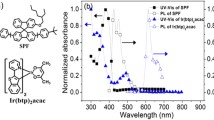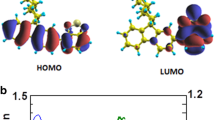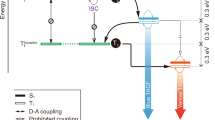Abstract
In this work, the complex excited state dynamics of a sky-blue emitting co-polymer {poly-[9,9′-dioctylfluorene-co-bis-N,N′-(4-butylphenyl)-bis-N,N′-phenyl-1,4-phenylenediamine]} is determined, using a time-resolved gated spectroscopy method, which helps to investigate the origin of delayed fluorescence in thin film. It is clearly shown that delayed fluorescence arises from triplet–triplet annihilation mechanism, which opens an indirect pathway to generate singlet excitons. Experimentally, the delayed fluorescence yield varies from 20% at room temperature to 46 ± 2% at 20 K, suggesting that an alternative triplet harvesting mechanism is operative to convert the triplet into emissive singlet states.



Similar content being viewed by others
References
Burroughes JH, Bradley DDC, Brown AR et al (1990) Light-emitting diodes based on conjugated polymers. Nature 347:539–541
Liang J, Li L, Niu X, Yu Z, Pei Q (2013) Elastomeric polymer light-emitting devices and displays. Nat Photon 7:817–824
Kondakov DY (2009) Role of triplet–triplet annihilation in highly efficient fluorescent devices. J Soc Inf Disp 17:137–144
Aydemir M, Vygintas J, Fernando BD, Andrew PM (2015) Inter/intrachain interactions behind the formation of charge transfer states in polyspirobifluorene: a case study for complex excited-state dynamics in different polarity index solvents. J Phys Chem C 119:5855–5863
Aydemir M, Haykır G, Battal A, Jankus V et al (2016) High efficiency OLEDs based on anthracene derivatives: the impact of electron donating and withdrawing group on the performance of OLED. Org Electron 30:149–157
Jankus V, Aydemir M, Dias FB, Monkman AP (2016) Generating light from upper excited triplet states: a contribution to the indirect singlet yield of a polymer OLED, helping to exceed the 25% singlet exciton limit. Adv Sci 3:1500221
Kondakov DY, Pawlik TD, Hatwar TK, Spindler JP (2009) Triplet annihilation exceeding spin statistical limit in highly efficient fluorescent organic light-emitting diodes. J Appl Phys 106:124510
Kondakov DY (2015) Triplet–triplet annihilation in highly efficient fluorescent organic light-emitting diodes: current state and future outlook. Philos Trans R Soc Math Phys Eng Sci 373:20140321
Köhler A, Bässler H (2015) Electronic processes in organic semiconductors: an introduction. Wiley, New York
Palilis L, Lidzey D, Redecker M et al (2001) High performance blue light-emitting diodes based on conjugated polymer blends. Synth Met Synth Met 121:1729–1730
Snaith HJ, Arias AC, Morteani AC, Silva C, Friend RH (2002) Charge generation kinetics and transport mechanisms in blended polyfluorene photovoltaic devices. Nano Lett Nano Lett 2:1353–1357
Arias AC, MacKenzie JD, Stevenson R et al (2001) Photovoltaic performance and morphology of polyfluorene blends: a combined microscopic and photovoltaic investigation. Macromolecules 34:6005–6013
Müllen K, Scherf U (2006) Organic light-emitting devices: synthesis, properties, and applications. Wiley, New York
Clare T (1986) An investigation of plasma polymerization and copolymerization using fluoroaromatic compounds, Dissertation, Durham University
Morteani AC, Friend RH, Silva C (2004) Endothermic exciplex–exciton energy-transfer in a blue-emitting polymeric heterojunction system. Chem Phys Lett 391:81–84
Morteani AC, Dooht AS, Kim JS, Silva C et al (2003) Barrier-free electron–hole capture in polymer blend heterojunction light-emitting diodes. Adv Mater 15:1708
Rothe C, Monkman AP (2003) Triplet exciton migration in a conjugated polyfluorene. Phys Rev B 68:075208
Cheung ECC (2010) Evolution of optical gain properties through three generations of electroluminescent fluorene-based polymers, Dissertation, Imperial College London
Author information
Authors and Affiliations
Corresponding author
Ethics declarations
Conflict of interest
The authors declare that they have no conflict of interest.
Additional information
Publisher's Note
Springer Nature remains neutral with regard to jurisdictional claims in published maps and institutional affiliations.
Electronic supplementary material
Below is the link to the electronic supplementary material.
Rights and permissions
About this article
Cite this article
Aydemir, M. The contribution of triplet excitons to the total singlet production yield in a sky-blue emitting co-polymer film. Polym. Bull. 76, 6429–6436 (2019). https://doi.org/10.1007/s00289-019-02729-8
Received:
Revised:
Accepted:
Published:
Issue Date:
DOI: https://doi.org/10.1007/s00289-019-02729-8




